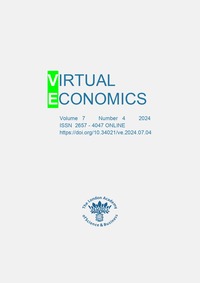Service Failure by Human, Service Recovery by AI Chatbot: The Impact of Justice, AI Efficacy on Recovery Effort
DOI:
https://doi.org/10.34021/ve.2024.07.04(3)Keywords:
artificial intelligence; chatbot; justice; chatbot efficacy; service recovery; forgivenessAbstract
Artificial intelligence has led to significant innovation in the marketing field, with intelligent chatbots increasingly involved in both customer service provision and service failure recovery processes. While recent research on AI services and intelligent chatbots has been increasing, there has been little research on the collaborative efforts between AI chatbots and human agents for service failure recovery and users' perceptions of the process. Accordingly, the aim of this study is to assess the impact of AI chatbot intervention in recovering from service failures made by human agents on key service recovery outcomes. To achieve this, we model the influence of perceived justice in AI chatbot service recovery processes on outcomes such as customer forgiveness and post-recovery customer satisfaction mediated through efficacy towards AI chatbots. Additionally, drawing on anthropomorphism theory, we seek to verify the moderation effect of humanness, representing the degree to which AI chatbots resemble humans. To test the hypotheses, a total of 187 respondents who had experienced service failure by human agents and service recovery through AI chatbots were surveyed. The collected data were then validated for reliability and validity, and the hypotheses were tested using PLS analysis. Empirical analysis results confirm the significance of all hypotheses and moderation effects. The findings of this study hold academic significance as an exploration of the proactive role of AI chatbots in service recovery processes, providing both theoretical insights and practical implications for companies intending to implement chatbots in service settings in the future.
Downloads
References
Xing, X., Song, M., Duan, Y., & Mou, J. (2022). Effects of different service failure types and recovery strategies on the consumer response mechanism of chatbots. Technology in Society, 70, 102049. https://doi.org/10.1016/j.techsoc.2022.102049
Hsu, C. L., & Lin, J. C. C. (2023). Understanding the user satisfaction and loyalty of customer service chatbots. Journal of Retailing and Consumer Services, 71, 103211. https://doi.org/10.1016/j.jretconser.2022.103211
Alt, M. A., & Ibolya, V. (2021). Identifying relevant segments of potential banking chatbot users based on technology adoption behavior. Market-Tržište, 33(2), 165–183. https://doi.org/10.22598/mt/2021.33.2.165
Dahiya, M. (2017). A tool of conversation: Chatbot. International Journal of Computer Sciences and Engineering, 5(5), 158–161. https://doi.org/10.26438/ijcse/v5i5.158161
Luo, X., Tong, S., Fang, Z., & Qu, Z. (2019). Frontiers: Machines vs. humans: The impact of artificial intelligence chatbot disclosure on customer purchases. Marketing Science, 38(6), 937–947. https://doi.org/10.1287/mksc.2019.1192
Zumstein, D., & Hundertmark, S. (2017). Chatbots – An interactive technology for personalized communication, transactions, and services. IADIS International Journal on WWW/Internet, 15(1), 96–109.
George, A. S., & George, A. H. (2023). A review of ChatGPT AI's impact on several business sectors. Partners Universal International Innovation Journal, 1(1), 9–23. https://doi.org/10.5281/zenodo.7644359
Janssen, A., Grützner, L., & Breitner, M. H. (2021). Why do chatbots fail? A critical success factors analysis. Proceedings of the International Conference on Information Systems (ICIS), 1–17.
Yoon, J., & Yu, H. (2022). Impact of customer experience on attitude and utilization intention of a restaurant-menu curation chatbot service. Journal of Hospitality and Tourism Technology, 13(3), 527–541. https://doi.org/10.1108/JHTT-03-2021-0089
Zhang, J., Zhu, Y., Wu, J., & Yu-Buck, G. F. (2023). A natural apology is sincere: Understanding chatbots' performance in symbolic recovery. International Journal of Hospitality Management, 108, 103387. https://doi.org/10.1016/j.ijhm.2022.103387
Lei, S. I., Shen, H., & Ye, S. (2021). A comparison between chatbot and human service: Customer perception and reuse intention. International Journal of Contemporary Hospitality Management, 33(11), 3977–3995. https://doi.org/10.1108/IJCHM-12-2020-1399
Lv, X., Yang, Y., Qin, D., Cao, X., & Xu, H. (2022). Artificial intelligence service recovery: The role of empathic response in hospitality customers’ continuous usage intention. Computers in Human Behavior, 126, 106993. https://doi.org/10.1016/j.chb.2021.106993
Song, M., Zhang, H., Xing, X., & Duan, Y. (2023). Appreciation vs. apology: Research on the influence mechanism of chatbot service recovery based on politeness theory. Journal of Retailing and Consumer Services, 73, 103323. https://doi.org/10.1016/j.jretconser.2023.103323
Chen, K., Chen, J., Zhan, W., & Sharma, P. (2020). When in Rome! Complaint contagion effect in multi-actor service ecosystems. Journal of Business Research, 121, 628–641. https://doi.org/10.1016/j.jbusres.2020.01.051
Ho, T. H., Tojib, D., & Tsarenko, Y. (2020). Human staff vs. service robot vs. fellow customer: Does it matter who helps your customer following a service failure incident? International Journal of Hospitality Management, 87, 102501. https://doi.org/10.1016/j.ijhm.2020.102501
Hart, C. W., Heskett, J. L., & Sasser Jr, W. E. (1990). The profitable art of service recovery. Harvard Business Review, 68(4), 148–156. Retrieved from https://hbr.org/1990/07/the-profitable-art-of-service-recovery
Larivière, B., Bowen, D., Andreassen, T. W., Kunz, W., Sirianni, N. J., Voss, C., ... & De Keyser, A. (2017). Service encounter 2.0: An investigation into the roles of technology, employees, and customers. Journal of Business Research, 79, 238–246. https://doi.org/10.1016/j.jbusres.2017.03.008
Rese, A., Ganster, L., & Baier, D. (2020). Chatbots in retailers’ customer communication: How to measure their acceptance? Journal of Retailing and Consumer Services, 56, 102176. https://doi.org/10.1016/j.jretconser.2020.102176
Zhu, Y., Zhang, J., Wu, J., & Liu, Y. (2022). AI is better when I'm sure: The influence of certainty of needs on consumers' acceptance of AI chatbots. Journal of Business Research, 150, 642–652. https://doi.org/10.1016/j.jbusres.2022.06.044
Khatri, C., Venkatesh, A., Hedayatnia, B., Gabriel, R., Ram, A., & Prasad, R. (2018). Alexa Prize—State of the art in conversational AI. AI Magazine, 39(3), 40–55. https://doi.org/10.1609/aimag.v39i3.2810
Um, T., Kim, T., & Chung, N. (2020). How does an intelligence chatbot affect customers compared with self-service technology for sustainable services? Sustainability, 12(12), 5119. https://doi.org/10.3390/su12125119
Agnihotri, A., & Bhattacharya, S. (2024). Chatbots’ effectiveness in service recovery. International Journal of Information Management, 76, 102679. https://doi.org/10.1016/j.ijinfomgt.2023.102679
Haupt, M., Rozumowski, A., Freidank, J., & Haas, A. (2023). Seeking empathy or suggesting a solution? Effects of chatbot messages on service failure recovery. Electronic Markets, 33(1), 56. https://doi.org/10.1007/s12525-023-00673-0
Yang, Z., Zhou, J., & Yang, H. (2023). The impact of AI’s response method on service recovery satisfaction in the context of service failure. Sustainability, 15(4), 3294. https://doi.org/10.3390/su15043294
Ozuem, W., Ranfagni, S., Willis, M., Salvietti, G., & Howell, K. (2024). Exploring the relationship between chatbots, service failure recovery, and customer loyalty: A frustration–aggression perspective. Psychology & Marketing, 41(10), 2253–2273. https://doi.org/10.1002/mar.22051
Prasongsukarn, K., & Patterson, P. G. (2012). An extended service recovery model: The moderating impact of temporal sequence of events. Journal of Services Marketing, 26(7), 510–520. https://doi.org/10.1108/08876041211266477
Liu, H., Jayawardhena, C., Dibb, S., & Ranaweera, C. (2019). Examining the trade-off between compensation and promptness in eWOM-triggered service recovery: A restorative justice perspective. Tourism Management, 75, 381–392. https://doi.org/10.1016/j.tourman.2019.05.008
Lim, W. M. (2020). An equity theory perspective of online group buying. Journal of Retailing and Consumer Services, 54, 101729. https://doi.org/10.1016/j.jretconser.2018.12.013
Kumar, M., & Kumar, N. (2016). Three dimensions of service recovery: Examining relationship and impact. Supply Chain Management: An International Journal, 21(2), 273–286. https://doi.org/10.1108/SCM-03-2015-0086
Martínez‐Tur, V., Peiró, J. M., Ramos, J., & Moliner, C. (2006). Justice perceptions as predictors of customer satisfaction: The impact of distributive, procedural, and interactional justice. Journal of Applied Social Psychology, 36(1), 100–119. https://doi.org/10.1111/j.0021-9029.2006.00005.x
Zhao, L., Lu, Y., Zhang, L., & Chau, P. Y. (2012). Assessing the effects of service quality and justice on customer satisfaction and the continuance intention of mobile value-added services: An empirical test of a multidimensional model. Decision Support Systems, 52(3), 645–656. https://doi.org/10.1016/j.dss.2011.10.022
Hossain, M. A., Yesmin, M. N., Jahan, N., & Kim, M. (2021). Effects of service justice, quality, social influence, and corporate image on service satisfaction and customer loyalty: Moderating effect of bank ownership. Sustainability, 13(13), 7404. https://doi.org/10.3390/su13137404
Muhammad, L. (2020). Mediating role of customer forgiveness between perceived justice and satisfaction. Journal of Retailing and Consumer Services, 52, 101886. https://doi.org/10.1016/j.jretconser.2019.101886
Joireman, J., Grégoire, Y., & Tripp, T. M. (2016). Customer forgiveness following service failures. Current Opinion in Psychology, 10, 76–82. https://doi.org/10.1016/j.copsyc.2015.11.005
Nussbaum, M. C. (2016). Anger and forgiveness: Resentment, generosity, justice. Oxford University Press. https://doi.org/10.1093/acprof:oso/9780199335879.001.0001
del Río-Lanza, A. B., Vázquez-Casielles, R., & Díaz-Martín, A. M. (2009). Satisfaction with service recovery: Perceived justice and emotional responses. Journal of Business Research, 62(8), 775–781. https://doi.org/10.1016/j.jbusres.2008.09.015
Schoefer, K., & Ennew, C. (2005). The impact of perceived justice on consumers' emotional responses to service complaint experiences. Journal of Services Marketing, 19(5), 261–270. https://doi.org/10.1108/08876040510609880
Sheehan, B., Jin, H. S., & Gottlieb, U. (2020). Customer service chatbots: Anthropomorphism and adoption. Journal of Business Research, 115, 14–24. https://doi.org/10.1016/j.jbusres.2020.04.030
Epley, N., Waytz, A., & Cacioppo, J. T. (2007). On seeing human: A three-factor theory of anthropomorphism. Psychological Review, 114(4), 864–886. https://doi.org/10.1037/0033-295X.114.4.864
Lee, D., Chang, C. Y., & Hur, H. (2021). Political consequences of income inequality: Assessing the relationship between perceived distributive fairness and political efficacy in Asia. Social Justice Research, 34, 342–372. https://doi.org/10.1007/s11211-021-00371-2
Peng, J., Chen, L., Yang, X., & Xie, L. (2024). Meaningfulness at work: Role of distributive justice, managerial respect, and work self-efficacy. Management Decision. Advance online publication. https://doi.org/10.1108/MD-08-2022-1078
Nix, J., Wolfe, S. E., Rojek, J., & Kaminski, R. J. (2015). Trust in the police: The influence of procedural justice and perceived collective efficacy. Crime & Delinquency, 61(4), 610–640. https://doi.org/10.1177/0011128714530548
Vimalkumar, M., Sharma, S. K., Singh, J. B., & Dwivedi, Y. K. (2021). ‘Okay Google, what about my privacy?’: Users' privacy perceptions and acceptance of voice-based digital assistants. Computers in Human Behavior, 120, 106763. https://doi.org/10.1016/j.chb.2021.106763
Rau, P. P., Li, Y., & Li, D. (2009). Effects of communication style and culture on the ability to accept recommendations from robots. Computers in Human Behavior, 25(2), 587–595. https://doi.org/10.1016/j.chb.2008.12.025
Bies, R. J. (2001). Interactional (in)justice: The sacred and the profane. Advances in Organizational Justice, 8, 91–118.
Yang, H. E., & Tsai, F. S. (2007). General ES-QUAL scales applied to websites satisfaction and loyalty model. Communications of the IIMA, 7(2), 115–126. https://doi.org/10.58729/1941-6687.1040
Wei, C., Liu, M. W., & Keh, H. T. (2020). The road to consumer forgiveness is paved with money or apology? The roles of empathy and power in service recovery. Journal of Business Research, 118, 321–334. https://doi.org/10.1016/j.jbusres.2020.06.061
Zehir, C., & Narcıkara, E. (2016). E-service quality and e-recovery service quality: Effects on value perceptions and loyalty intentions. Procedia - Social and Behavioral Sciences, 229, 427–443. https://doi.org/10.1016/j.sbspro.2016.07.153
Ali, A. A. (2023). Are you open to forgiveness? Investigating service recovery strategies in the banking sector. In Financial and monetary policies for fostering European integration: Proceedings of the Economics International Conference (Vol. 25, pp. 25–53).
Hu, P., & Lu, Y. (2021). Dual humanness and trust in conversational AI: A person-centered approach. Computers in Human Behavior, 119, 106727. https://doi.org/10.1016/j.chb.2021.106727
Chung, M., Ko, E., Joung, H., & Kim, S. J. (2020). Chatbot e-service and customer satisfaction regarding luxury brands. Journal of Business Research, 117, 587–595. https://doi.org/10.1016/j.jbusres.2018.10.004
De Visser, E. J., Monfort, S. S., Goodyear, K., Lu, L., O’Hara, M., Lee, M. R., ... & Krueger, F. (2017). A little anthropomorphism goes a long way: Effects of oxytocin on trust, compliance, and team performance with automated agents. Human Factors, 59(1), 116–133. https://doi.org/10.1177/0018720816687205
Choi, Y., Choi, M., Oh, M., & Kim, S. (2020). Service robots in hotels: Understanding the service quality perceptions of human-robot interaction. Journal of Hospitality Marketing & Management, 29(6), 613–635. https://doi.org/10.1080/19368623.2020.1703871
Rodríguez-Ardura, I., & Meseguer-Artola, A. (2020). Editorial: How to prevent, detect and control common method variance in electronic commerce research. Journal of Theoretical and Applied Electronic Commerce Research, 15(2), 1–5. https://doi.org/10.4067/S0718-18762020000200101
Baumgartner, H., & Steenkamp, J.-B. E. M. (2001). Response styles in marketing research: A cross-national investigation. Journal of Marketing Research, 38(2), 143–156. https://doi.org/10.1509/jmkr.38.2.143.18840
Compeau, D. R., & Higgins, C. A. (1995). Application of social cognitive theory to training for computer skills. Information Systems Research, 6(2), 118–143. https://doi.org/10.1287/isre.6.2.118
Seth, I., Cox, A., Xie, Y., Bulloch, G., Hunter-Smith, D. J., Rozen, W. M., & Ross, R. (2023). Evaluating chatbot efficacy for answering frequently asked questions in plastic surgery: A ChatGPT case study focused on breast augmentation. Aesthetic Surgery Journal, 40(10), 1126–1135. https://doi.org/10.1093/asj/sjad140
Cassidy, R., & Shin, H. (2015). The effects of harm directions and service recovery strategies on customer forgiveness and negative word-of-mouth intentions. Journal of Retailing and Consumer Services, 27, 103–112. https://doi.org/10.1016/j.jretconser.2015.07.012
Lam, L. W. (2012). Impact of competitiveness on salespeople’s commitment and performance. Journal of Business Research, 65(9), 1328–1334. https://doi.org/10.1016/j.jbusres.2011.10.026
Fornell, C., & Larcker, D. F. (1981). Evaluating structural equation models with unobservable variables and measurement error. Journal of Marketing Research, 18(1), 39–50. https://doi.org/10.1177/002224378101800104
Hair, J. F. Jr., Sarstedt, M., Hopkins, L., & Kuppelwieser, V. G. (2014). Partial least squares structural equation modeling (PLS-SEM): An emerging tool in business research. European Business Review, 26(2), 106–121. https://doi.org/10.1108/EBR-10-2013-0128
Ahmed, R. R., Streimikiene, D., Channar, Z. A., Soomro, R. H., & Streimikis, J. (2021). E-banking customer satisfaction and loyalty: Evidence from serial mediation through modified ES-QUAL model and second-order PLS-SEM. Engineering Economics, 32(5), 407–421. https://doi.org/10.5755/j01.ee.32.5.28997
Wong, K. K.-K. (2016). Technical note: Mediation analysis, categorical moderation analysis, and higher-order constructs modeling in partial least squares structural equation modeling (PLS-SEM): A B2B example using SmartPLS. Marketing Bulletin, 26, 1–22.
Downloads
Published
How to Cite
Issue
Section
License

This work is licensed under a Creative Commons Attribution-NonCommercial 4.0 International License.





